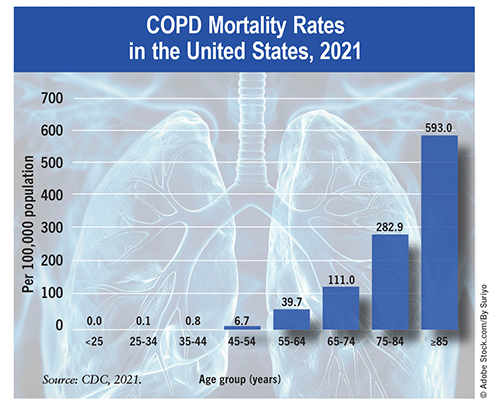US Pharm. 2024;49(7):14.
Chronic obstructive pulmonary disease (COPD) is a group of conditions (most commonly, chronic bronchitis and emphysema) that obstruct airflow into the lungs and cause difficulty breathing. The recent CDC National Health Interview Survey noted that adults with COPD are usually cigarette smokers, have lower income, and are at greater risk for certain illnesses. In the United States, the estimated cost of overall medical care for patients aged ≥45 years with COPD is $24 billion annually. For U.S. adults, COPD rates are lowest in Hawaii (3.5%) and highest in West Virginia (13.1%).

Prevalence: COPD prevalence rates have remained steady over the past decade. Collectively, these conditions affect ~4.6% of U.S. adults (~11.7 million people). Rates are highest among non-Hispanic white adults (5.6% vs. 4.1%, 2.8%, and 2.3% in those of black, Hispanic, and other races/ethnicities, respectively), women (5.0% vs. 4.1% in men), and individuals aged ≥65 years (9.7% vs. 5.4% and 1.5% in those aged 45-64 years and 18-44 years, respectively). Trends were similar when data for chronic bronchitis and emphysema were assessed separately, except for the greater prevalence of emphysema in men (1.6% vs. 1.4% for women, respectively).
Associated Risks: In 2022, COPD rates in the U.S. were nearly seven times higher among adult current cigarette smokers (12.6%) and more than four times higher among former smokers (8.2%) than among never-smokers (1.9%). Rates were higher among adults and families at poverty threshold or lower, compared with those with income levels at least two times the poverty threshold (7.4%-9.7% vs. 3.2%, respectively). Roughly 49.5% of adults with COPD (vs. 22.7% of those without COPD) had received an anxiety or depression diagnosis, and 35.1% (vs. 8.0% of those without COPD) had ≥1 disability limiting daily functioning. In 2020, the rate of hospitalization for COPD decreased from previous years, to 101.3 per 100,000 population (~335,000 hospitalizations). COPD-associated emergency department visits declined to 279.1 per 100,000 (~925,000 hospitalizations) from previous years. These decreases may be attributable to the COVID-19 pandemic and the resulting avoidance or limited availability of healthcare services.
Mortality: COPD was the 6th leading cause of mortality in 2021, accounting for >138,000 deaths. Age-adjusted mortality rates for COPD were similar between men and women (36.8 vs. 36.3 per 100,000, respectively); however, in men the rate has decreased by 36% over the past 2 decades, whereas in women it remained steady until 2017 and has since decreased by 15%. White men and women had the highest COPD mortality rates (41.5 and 37.4 per 100,000, respectively), and male and female Asian/Pacific Islanders had the lowest (12.4 and 5.9 per 100,000, respectively). Overall, most deaths from COPD (85%) have occurred in persons aged ≥65 years, but the mortality rate in this group is going down.
The content contained in this article is for informational purposes only. The content is not intended to be a substitute for professional advice. Reliance on any information provided in this article is solely at your own risk.
To comment on this article, contact rdavidson@uspharmacist.com.






